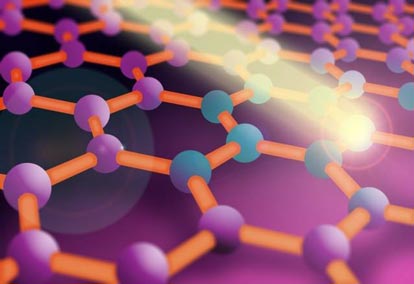
Researchers at MIT have discovered a novel way of controlling graphene’s electrical behavior, using light pulses to modify the material’s conductivity.
Because of its lightness and efficacy, graphene has been one of the most talked-about materials in recent years, with a wide range of still-untapped uses and applications in science and technology. In a paper recently published in Physical Review Letters, MIT scientists have described how modifying the electron concentration of graphene changes its electrical behavior, after observing how the material reacted to a short light pulse. These findings could potentially lead to ultra-fast graphene broadband light detectors.
The researchers discovered that when a light pulse was applied to graphene with a lower electron concentration, it increased the material’s electrical conductivity. In contrast, when the light pulse was applied to graphene with a higher electron concentration, it decreased the material’s conductivity. In this way, scientists found that high electron-concentration graphene behaved like a typical metal, while low electron-concentration graphene behaved more like a typical semiconductor, such as silicon. Thus, scientists realized that by calibrating the electron concentration of graphene, they could calibrate the electrical response and conductive abilities of graphene as well.
“We were able to tune the number of electrons in graphene, and get either response,” Alex Frenzel, Ph.D. student and lead author of the study, said in a recent MIT press release.
The study’s experimental setup consisted of graphene atop a layer of insulation and a thin metallic film. By administering a voltage between the bottom electrode and graphene, scientists were able to tune the graphene’s electron concentration. The researchers then applied a strong light pulse to the graphene, before applying a second, lower-frequency pulse, in order to chart the change in the graphene’s electrical conductivity.
“We use two different light pulses: one to modify the material, and one to measure the electrical conduction,” Nuh Gedik, Ph.D., professor of physics at MIT and one of the authors of the study, explained. He added that the device had to be transparent in order to ensure that the light pulses used in the experiment would effectively pass through.
Gedik called the method used in the experiment a “cool technique,” as the experiment’s all-optic method ensured that superfluous and distracting electrical contacts were not added to the graphene.
“Normally, to measure conductivity you have to put leads on it,” he said. However, this new technique “has no contact at all.”
Importantly, by using such short light pulses to measure conductivity, researchers can change and chart graphene’s electrical responses in record time – barely a trillionth of a second.
The researchers also offered an explanation for the poor conductive abilities of graphene with a high electron concentration, resulting from a special characteristic of the material. Graphene, unlike other materials, has electrons that travel at constant speeds, similar to photons.When the temperature of the electrons rises because of the light pulses, the highly-electron-concentrated graphene’s conductivity decreases.
“Our experiment reveals that the cause of photoconductivity in graphene is very different from that in a normal metal or semiconductor,” Frenzel said.
According to researchers working on the project, these new findings could result in powerful, ultra-fast and ultra-responsive light detectors across a wide range of frequencies. However, currently, the absorption percentage of the graphene is low. To aid in the development of such light detectors and increase absorption efficiency, MIT scientists suggest layering the graphene.
“The work is interesting because it presents a systematic study of the doping dependence of the low-energy dynamics, which has not received much attention so far,” Isabella Gierz, a professor at the Max Planck Institute for the Structure and Dynamics of Matter in Hamburg, Germany, who did not participate in the research, told an MIT reporter. According to Gierz, the research “certainly helps to reconcile previous apparently contradicting results,” concluding that it represents “a solid experiment, analysis, and interpretation.”
– Melanie Abeygunawardana





